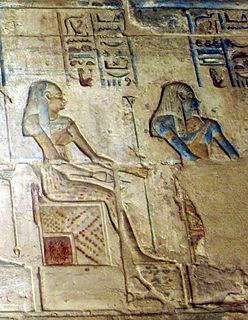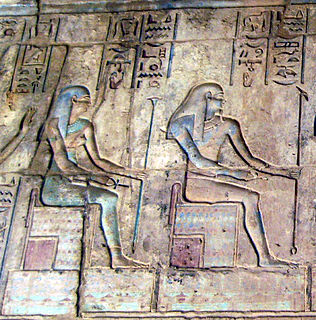
Horus or Heru, Hor, Har in Ancient Egyptian, is one of the most significant ancient Egyptian deities who served many functions, most notably god of kingship and the sky. He was worshipped from at least the late prehistoric Egypt until the Ptolemaic Kingdom and Roman Egypt. Different forms of Horus are recorded in history and these are treated as distinct gods by Egyptologists. These various forms may possibly be different manifestations of the same multi-layered deity in which certain attributes or syncretic relationships are emphasized, not necessarily in opposition but complementary to one another, consistent with how the Ancient Egyptians viewed the multiple facets of reality. He was most often depicted as a falcon, most likely a lanner falcon or peregrine falcon, or as a man with a falcon head.

Thoth is an ancient Egyptian deity. In art, he was often depicted as a man with the head of an ibis or a baboon, animals sacred to him. His feminine counterpart was Seshat, and his wife was Ma'at. He was the god of the moon, wisdom, writing, hieroglyphs, science, magic, art, and judgment. His Greek equivalent is Hermes.

Nut, also known by various other transcriptions, is the goddess of the sky, stars, cosmos, mothers, astronomy, and the universe in the ancient Egyptian religion. She was seen as a star-covered nude woman arching over the Earth, or as a cow. She was depicted wearing the water-pot sign (nw) that identifies her.

Nu, feminine Naunet, is the deification of the primordial watery abyss in the Hermopolitan Ogdoad cosmogony of ancient Egyptian religion. The name is paralleled with nen "inactivity" in a play of words in, "I raised them up from out of the watery mass [nu], out of inactivity [nen]". The name has also been compared to the Coptic noun "abyss; deep".
Nu is the one of the eight deities of the Ogdoad representing ancient Egyptian primordial Chaos from which the Primeval Mound appeared. He is coupled with goddess Naunet and appears in anthropomorphic form but with the head of a frog. No cult is addressed to Nun but he is typically depicted in ancient Egyptian art holding aloft the solar barque or the sun disc. He may appear greeting the rising sun in the guise of a baboon. Nun is otherwise symbolized by the presence of a sacred cistern or lake as in the sanctuaries of Karnak and Dendara.

Amunet or Imnt ; also spelled Amonet or Amaunet; Koinē Greek: Αμαυνι) is a primordial goddess in ancient Egyptian religion. Thebes was the center of her worship through the last dynasty, the Ptolemaic Kingdom, in 30 BC. She is attested in the earliest known of Egyptian religious texts and, as was the custom, was paired with a counterpart who is entitled with the same name, but in the masculine, Amun. They were thought to have existed prior to the beginning of creation along with three other couples representing primeval concepts.

Kek is the deification of the concept of primordial darkness in the ancient Egyptian Ogdoad cosmogony of Hermopolis.

Maat or Maʽat refers to the ancient Egyptian concepts of truth, balance, order, harmony, law, morality, and justice. Maat was also the goddess who personified these concepts, and regulated the stars, seasons, and the actions of mortals and the deities who had brought order from chaos at the moment of creation. Her ideological opposite was Isfet, meaning injustice, chaos, violence or to do evil.
In Egyptian mythology, Am-heh was a minor god from the underworld, whose name means either "devourer of millions" or "eater of eternity". He was depicted as a man with the head of a hunting dog who lived in a lake of fire. He is sometimes seen as an aspect of Ammit, the personification of divine retribution. Am-heh could only be repelled by the god Atum.

Babi, also Baba, in ancient Egyptian religion, was the deification of the hamadryas baboon, one of the animals present in ancient Egypt. His name is usually translated as "bull of the baboons", roughly meaning "chief of the baboons".

In classical mythology, Hermanubis was a god who combined Hermes with Anubis.
In Egyptian mythology, the hennu boat or Sokar barque was a symbol of the god Seker of Memphis. Depending on the era or the prevailing dynasty of Egypt, the hennu boat sailed toward either dawn or dusk.

Sir Ernest Alfred Thompson Wallis Budge was an English Egyptologist, Orientalist, and philologist who worked for the British Museum and published numerous works on the ancient Near East. He made numerous trips to Egypt and the Sudan on behalf of the British Museum to buy antiquities, and helped it build its collection of cuneiform tablets, manuscripts, and papyri. He published many books on Egyptology, helping to bring the findings to larger audiences. In 1920, he was knighted for his service to Egyptology and the British Museum.

Heqet, sometimes spelled Heket, is an Egyptian goddess of fertility, identified with Hathor, represented in the form of a frog. To the Egyptians, the frog was an ancient symbol of fertility, related to the annual flooding of the Nile. Heqet was originally the female counterpart of Khnum, or the wife of Khnum by whom she became the mother of Her-ur. It has been proposed that her name is the origin of the name of Hecate, the Greek goddess of witchcraft.

Geb was the Egyptian god of the earth and a mythological member of the Ennead of Heliopolis. He could also be considered a father of snakes. It was believed in ancient Egypt that Geb's laughter created earthquakes and that he allowed crops to grow.

El-Tod was the site of an ancient Egyptian town and a temple to the Egyptian god Montu. It is located 20 kilometres (12 mi) southwest of Luxor, Egypt, near the settlement of Hermonthis. A modern village now surrounds the site.

Raet (Rˁỉ.t) or Raet-Tawy (Rˁỉ.t-tȝ.wỉ) is an ancient Egyptian solar deity, the female aspect of Ra. Her name is simply the female form of Ra's name; the longer name Raet-Tawy means "Raet of the Two Lands".

In Egyptian mythology, the Ogdoad were eight primordial deities worshiped in Hermopolis.
Amu-Aa or, is one of the gods that goes with Osiris during the second hour of the night.
Perit is an underworld deity in Egyptian mythology. She is one of the twelve goddesses in the ninth sector of Duat.

















